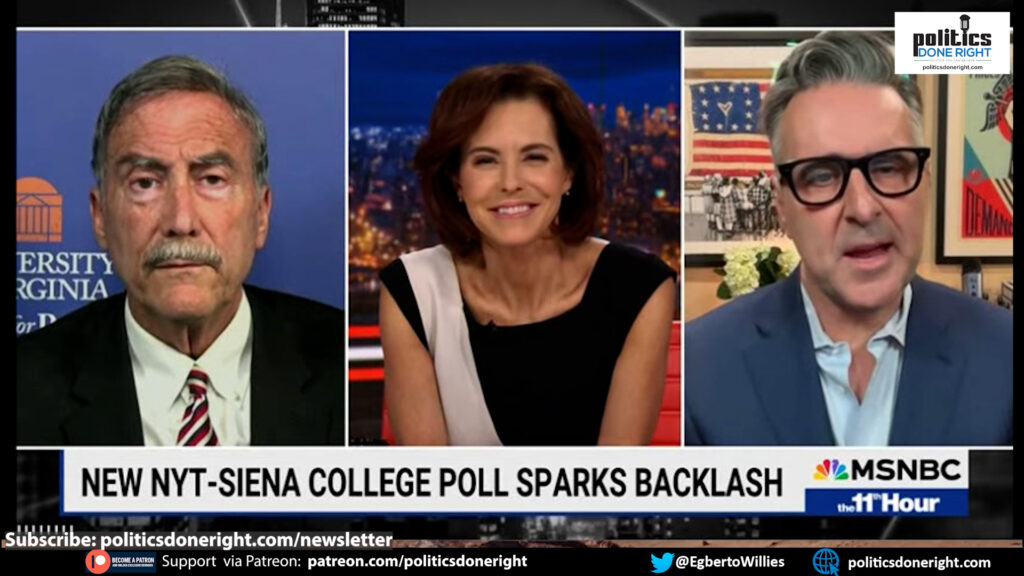Ignore the polls. They have been skewed right since Trump’s electoral college win/popular vote loss. I still expect a Democratic Landslide. But we must do the work.
Democratic landslide.
Podcasts (Video — Audio)
A New York Times/Siena poll recently sparked significant alarm among Democrats, suggesting that President Biden is trailing in key Midwestern swing states. This narrative, quickly embraced by mainstream media, paints a bleak picture for the upcoming elections. However, such interpretations demand scrutiny and context. As historical precedents illustrate, polls often fail to capture the complexities and dynamism of voter behavior accurately.
When examining these polls, it is crucial to consider the methodologies employed and the contexts within which they were conducted. Polling often hinges on models predicting “likely voters,” which can be inherently flawed if they do not account for shifts in voter engagement, demographic changes, or emerging issues that motivate different segments of the electorate. The recent polls, for instance, may not fully reflect the progressive surge or the younger demographics that increasingly influence electoral outcomes.
Historical examples underscore the unreliability of polls as definitive predictors. In 2016, many polls underestimated Trump’s appeal in critical states, while in 2020, they overestimated Biden’s margins in several regions. These discrepancies highlight a persistent issue: polls can mislead when they do not account for voter enthusiasm, last-minute shifts, or unconventional voting patterns.
Pollsters like Larry Sabato from the University of Virginia and John Della Volpe from Harvard’s Kennedy School have voiced skepticism about the recent New York Times/Siena poll results. Sabato laughed at the notion that Trump could lead by double digits in Nevada, a state that has leaned Democratic for decades. Della Volpe questioned the stark disparities in youth voting preferences between Michigan and Wisconsin, noting that such internal inconsistencies warrant a closer examination of the polling methodology.
Critically, these polls often contribute to a narrative that may not align with the on-ground realities of political campaigns. The media’s focus on polling results can overshadow substantive discussions about policy and governance. As Sabato notes, the excessive emphasis on fluctuating poll numbers detracts from more pressing issues, such as Trump’s controversial statements about extending presidential terms or his alarming references to authoritarian regimes.
This misplaced focus can lead to voter complacency or unnecessary panic. Instead, Democrats must concentrate on mobilizing their base, addressing key issues, and highlighting the stark policy contrasts between themselves and their opponents. The right-wing agenda, often lacking in substantive policy proposals, becomes particularly vulnerable when juxtaposed with Democratic efforts to protect healthcare, women’s rights, and economic stability.
Moreover, the current political landscape offers unique opportunities for Democrats. Progressive victories in traditionally conservative states on issues like abortion and healthcare have demonstrated that voters, when faced with personal and ethical decisions, often choose policies that align with Democratic values. These successes underscore the importance of engaging voters on issues impacting their lives.
The rise of grassroots movements and the availability of digital platforms also empower Democrats to circumvent traditional media narratives and connect directly with voters. Crowdsourcing and social media campaigns enable the dissemination of progressive messages, mobilizing support in ways that conventional polling methods may not capture.
The recent alarm over polling should catalyze action rather than a source of despair. To secure a Democratic landslide, it is imperative to focus on voter registration drives, grassroots organizing, and robust fundraising efforts. Supporting organizations and campaigns that effectively communicate the stakes of the upcoming election is crucial. This includes supporting progressive media outlets and advocacy groups that can counter right-wing misinformation and energize the Democratic base.
Ultimately, elections are decided not by polls but by voters. By engaging in active participation, from canvassing and phone banking to digital campaigning and community organizing, Democrats can shape the electoral landscape. Encouraging voter turnout, especially among historically underrepresented groups, remains key to achieving a landslide victory.
While polls can offer snapshots of public opinion, they are not definitive forecasts. Democrats should approach them critically and focus on proactive strategies to influence voter behavior. By emphasizing policy differences, leveraging grassroots power, and maintaining an unwavering commitment to democratic principles, a Democratic landslide remains within reach. The path to victory lies not in fretting over polls but in making the polls reflect the collective will of a motivated and engaged electorate.
Viewers are encouraged to subscribe and join the conversation for more insightful commentary and to support progressive messages. Together, we can populate the internet with progressive messages that represent the true aspirations of most Americans.

